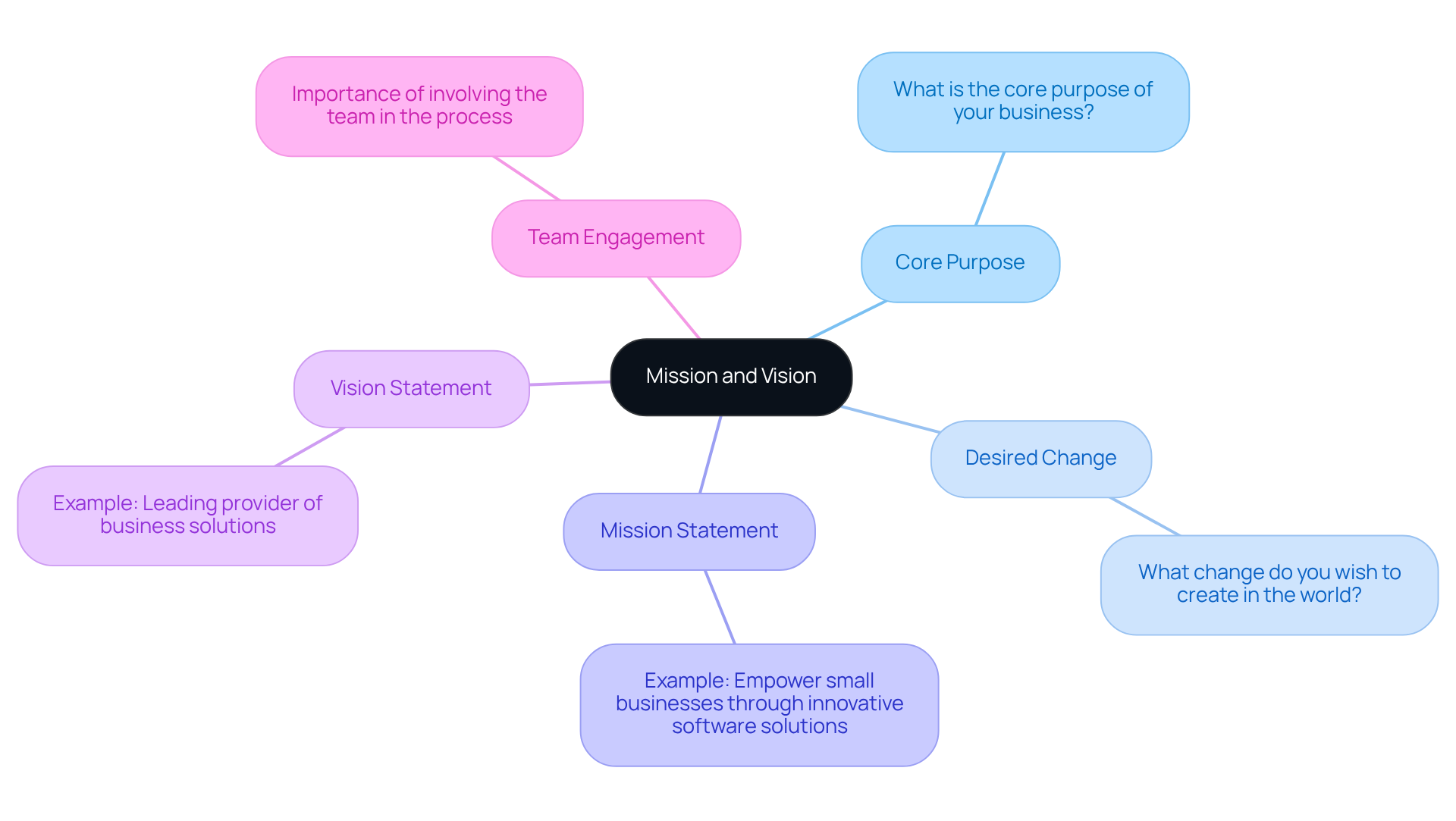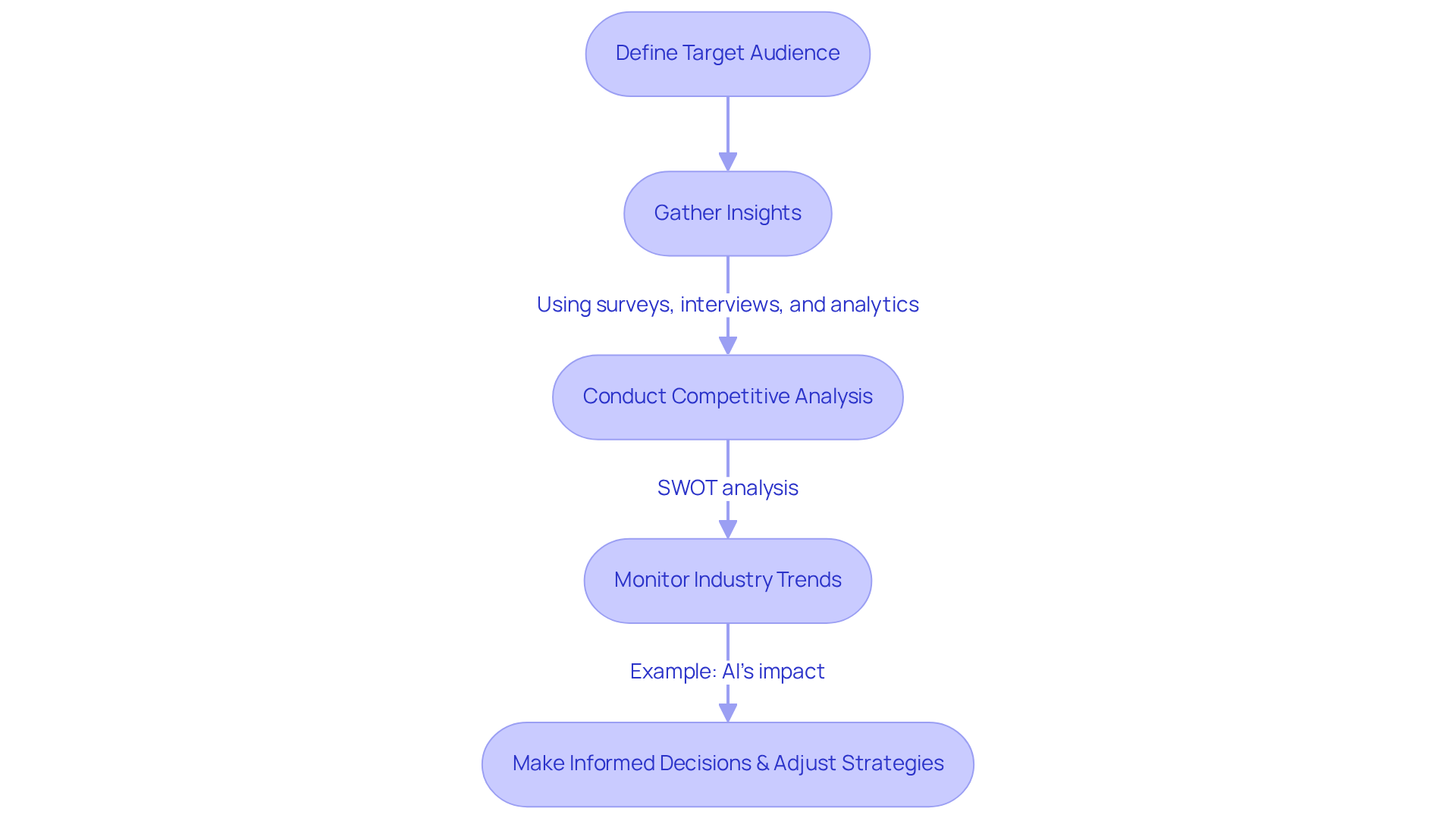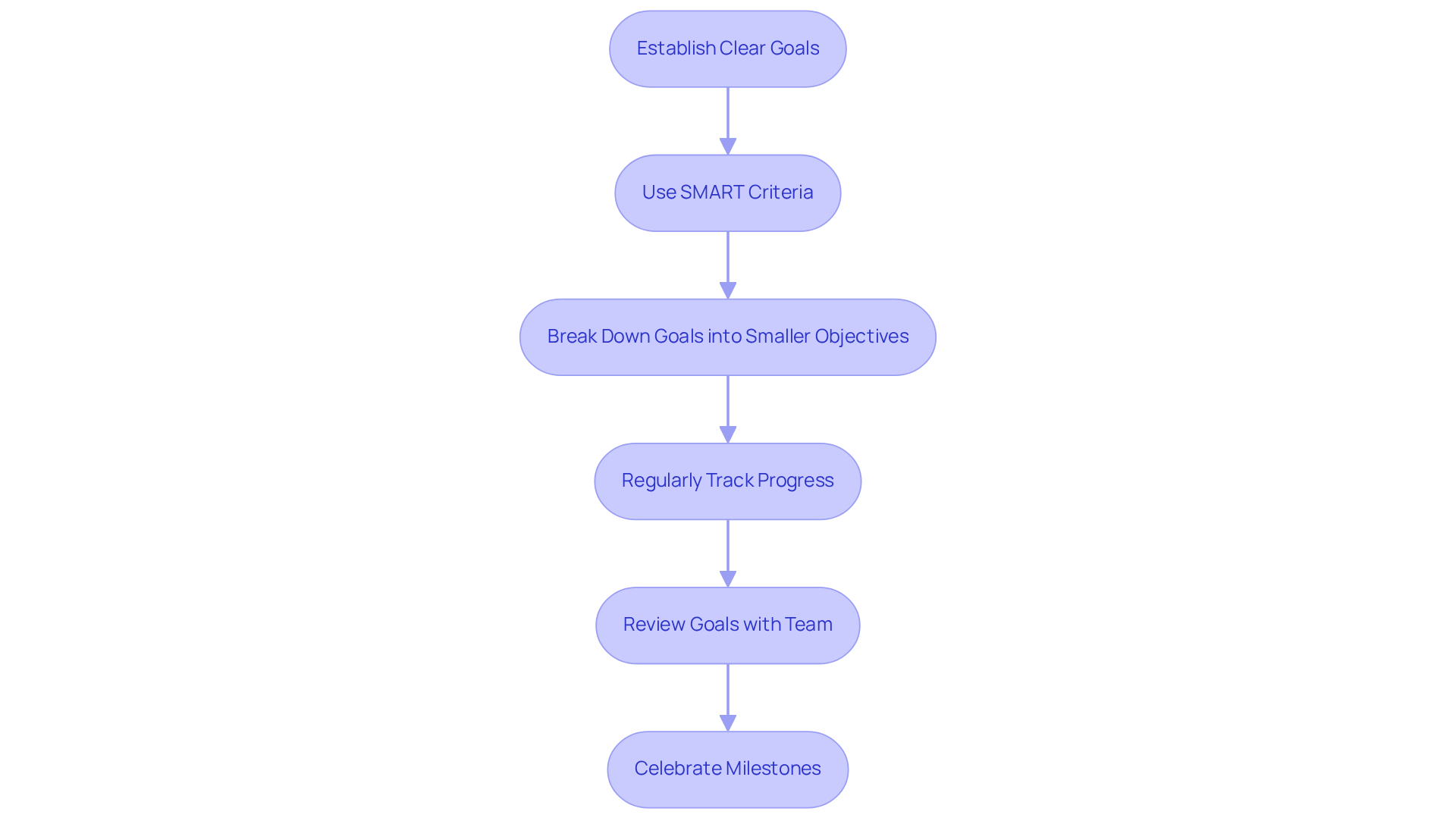Overview
Starting a new venture can feel overwhelming, and many founders grapple with the uncertainty of how to effectively strategize their brand. The challenges of defining a clear mission and vision, understanding the market landscape, and setting achievable goals can often lead to frustration and confusion. It’s essential to recognize these struggles, as they are common among entrepreneurs navigating the startup world.
To address these issues, the article outlines four essential steps for effective brand strategic planning in startups:
- Define your mission and vision, which serves as the foundation for your brand.
- Conduct a comprehensive market analysis to truly understand consumer needs and the competitive landscape.
- Establish measurable goals and objectives, providing direction and focus for your efforts.
- Create a flexible strategic plan to ensure that you can adapt to the ever-changing environment of launching and growing a successful startup.
Each step is not just a checklist but a supportive framework that underscores the significance of clarity, adaptability, and empathy in your journey. By embracing these principles, you can navigate the challenges ahead with confidence and resilience. Remember, you are not alone in this journey—many have faced similar obstacles and emerged stronger. As you move forward, let these insights guide you, fostering a nurturing and supportive atmosphere for your startup's growth.
Introduction
Crafting a successful startup can feel daunting, especially when the odds are stacked against you. With a staggering 90% of new ventures facing failure, the pressure to succeed can be overwhelming. It's crucial to understand that effective brand strategic planning is not just an option; it’s a lifeline. The components of mission, vision, market analysis, and goal setting are not mere buzzwords; they are essential for your survival and growth in a competitive landscape.
Imagine pouring your heart and soul into your idea, only to see it falter because the foundation wasn’t solid. This is a reality many founders face, and it’s understandable to feel disheartened. But you are not alone in this journey. This article explores four actionable steps designed to empower you to define your purpose, adapt to market demands, and set measurable goals. These steps are not just strategies; they are your roadmap to resilience.
How can you navigate the complexities of strategic planning? By embracing these steps, you can ensure that your startup not only stands out but thrives amidst the challenges. Let’s embark on this journey together, transforming uncertainty into opportunity, and fostering a community of support for one another.
Define Your Mission and Vision
To outline your objectives and vision, start by asking yourself some essential questions:
- What is the core purpose of your business?
- What change do you wish to create in the world?
Your mission statement should clearly convey your venture's purpose and how it serves its audience. For example, a technology company might express, 'To empower small businesses through innovative software solutions.'
Your should articulate your long-term aspirations, such as, 'To be the leading provider of business solutions that drive growth and efficiency.'
It's important to engage your team in this process, fostering a sense of buy-in and alignment across the organization. Remember to consistently review and refine these declarations as your business evolves.
Studies indicate that new ventures with clearly articulated purpose statements are more likely to thrive, as they provide clarity and guidance, helping to navigate obstacles and seize opportunities in a competitive landscape. With recent data showing that up to 90% of new ventures do not succeed, the necessity for a clear purpose and vision becomes even more apparent.
Additionally, 42% of startups fail due to a misunderstanding of consumer demand, underscoring the importance of aligning your goals with industry needs. Successful tech companies, like Airbnb, have mission statements that reflect their core values and aspirations, illustrating the power of well-crafted mission and vision statements.
By sharing your journey and learning from others, you can create a supportive environment that nurtures growth and fosters success.

Conduct a Comprehensive Market Analysis
To embark on a thorough analysis of your sector, it's crucial to start by defining your target audience clearly. Many founders face the daunting task of understanding customer preferences and behaviors, which can feel overwhelming. By utilizing surveys, interviews, and social media analytics, you can gather valuable insights that will help you connect with your audience.
A report highlights that 92% of business owners believe having the right digital tools is essential for success in new ventures, underscoring the significance of grasping your audience's needs. After this, consider performing a competitive analysis to identify the strengths and weaknesses of your rivals. Tools like SWOT analysis can visualize this data effectively, illuminating paths forward.
It's also vital to monitor industry trends and economic factors that could impact your venture. For instance, in the tech sector, the rise of artificial intelligence is reshaping customer expectations and product development. As Josh Howarth insightfully notes, 'Most startups fail because they exhaust their funds,' which reminds us of the importance of comprehensive analysis to avoid common pitfalls like misinterpreting demand or depleting resources.
By combining this information, you can make informed choices and adapt your strategies to meet evolving demands. A successful case study is Stripe, which focused on understanding its market and customer needs, leading to its valuation of $95 billion in 2021. This deep understanding will empower you to and adjust your strategies accordingly, fostering a sense of confidence in your journey.

Establish Measurable Goals and Objectives
Establishing clear goals can often feel overwhelming for many startup founders. The ambiguity of vague objectives, like 'We want to increase sales,' can lead to confusion and frustration. Instead, let’s embrace the SMART criteria to create a more defined target: 'We aim to increase sales by 20% over the next quarter.' This clarity not only provides direction but also , allowing you to feel more in control of your journey.
Breaking down larger goals into smaller, actionable objectives can make the process feel less daunting. By tracking these objectives regularly, you ensure that progress is visible and manageable. Consider employing project management tools such as Mooncamp, Asana, and Viva Goals to help monitor these objectives and adjust strategies as needed. This fosters a dynamic approach to achieving your goals.
Regularly reviewing these goals with your team is crucial for maintaining focus and motivation. Did you know that companies that review their goals quarterly are 31% more likely to achieve them? Furthermore, organizations with a robust KPI monitoring framework report a 12% increase in employee engagement. These statistics highlight the importance of connection and accountability within your team.
Celebrating milestones can significantly boost team morale and encourage ongoing commitment to achieving your objectives. Think about various ways to celebrate achievements, whether it’s rewarding yourself or sharing successes on social media. By integrating these practices, new businesses can create a robust framework for growth and innovation. As Michael Shvartsman wisely states, 'Clarity and focus are the backbone of a thriving startup.' Remember, you are not alone on this journey; together, we can navigate the path to success.

Create a Flexible Strategic Plan
Creating a flexible brand strategic planning can feel overwhelming, especially when you’re trying to navigate the ever-changing landscape of . It’s common to feel the weight of long-term commitments that can stifle your ability to adapt. This is where comes into play, offering a way to facilitate 30-day planning and renewal choices. By doing so, you can adjust your strategy to meet shifting conditions without the burden of long-term responsibilities.
This approach not only helps prevent scope creep but also fosters an environment of clear communication and collaborative project management. Imagine having regular review points—monthly or quarterly—where you can assess your progress and make necessary adjustments based on market feedback and performance data. This kind of structure encourages a culture of agility within your team, allowing for swift changes without losing sight of your overall mission.
Utilizing frameworks like OKRs (Objectives and Key Results) can also be beneficial. They help maintain alignment while providing the flexibility needed to achieve your goals. This brand strategic planning not only prepares your startup for challenges but also fosters innovation and responsiveness. Remember, you’re not alone in this journey; with the right support and strategies, your startup can thrive amidst uncertainty.
Conclusion
Establishing an effective brand strategic planning process can feel daunting for startups striving to find their place in a competitive landscape. The reality is that without a clear mission and vision, along with a thorough market analysis, measurable goals, and a flexible strategic plan, the journey can become overwhelming. These elements are not just checkboxes; they are essential for positioning your startup for sustainable growth and success. Each step is vital in ensuring your business not only survives but thrives despite the challenges you may face.
Throughout this discussion, we recognize the importance of a well-defined mission and vision, which serve as the bedrock of your startup's identity and direction. Understanding the market through careful analysis is equally crucial, as insights into consumer behavior and competitive dynamics can significantly inform your strategic decisions. Moreover, embracing the SMART criteria for goal-setting and valuing flexibility in your planning empowers you to adapt and evolve in response to the ever-shifting landscape.
Ultimately, the journey of building a startup is filled with uncertainty, but with a solid strategic planning framework, you can navigate this landscape with confidence. By embracing these best practices, you not only enhance your chances of success but also cultivate a culture of innovation and resilience. We encourage you to take proactive steps in defining your brand strategy, ensuring you remain aligned with your mission while adapting to the dynamic demands of the market. Remember, you are not alone in this journey; together, we can foster a supportive community that champions your growth and success.
Frequently Asked Questions
What is the purpose of defining a mission and vision for a business?
Defining a mission and vision provides clarity and guidance for the business, helping to navigate obstacles and seize opportunities in a competitive landscape.
What questions should I ask to outline my business's mission and vision?
You should ask yourself: What is the core purpose of your business? What change do you wish to create in the world?
How should a mission statement be structured?
A mission statement should clearly convey your venture's purpose and how it serves its audience. For example, "To empower small businesses through innovative software solutions."
What should a vision statement articulate?
A vision statement should articulate your long-term aspirations, such as, "To be the leading provider of business solutions that drive growth and efficiency."
Why is it important to engage the team in creating the mission and vision?
Engaging your team fosters a sense of buy-in and alignment across the organization, which is vital for the success of the mission and vision.
How often should mission and vision statements be reviewed?
It is important to consistently review and refine these declarations as your business evolves.
What do studies indicate about new ventures with clear purpose statements?
Studies indicate that new ventures with clearly articulated purpose statements are more likely to thrive, as they help provide clarity and guidance.
What percentage of startups fail due to a misunderstanding of consumer demand?
42% of startups fail due to a misunderstanding of consumer demand, highlighting the importance of aligning goals with industry needs.
Can you provide an example of a successful company's mission statement?
Successful tech companies, like Airbnb, have mission statements that reflect their core values and aspirations, illustrating the power of well-crafted mission and vision statements.
How can sharing experiences contribute to business success?
By sharing your journey and learning from others, you can create a supportive environment that nurtures growth and fosters success.




